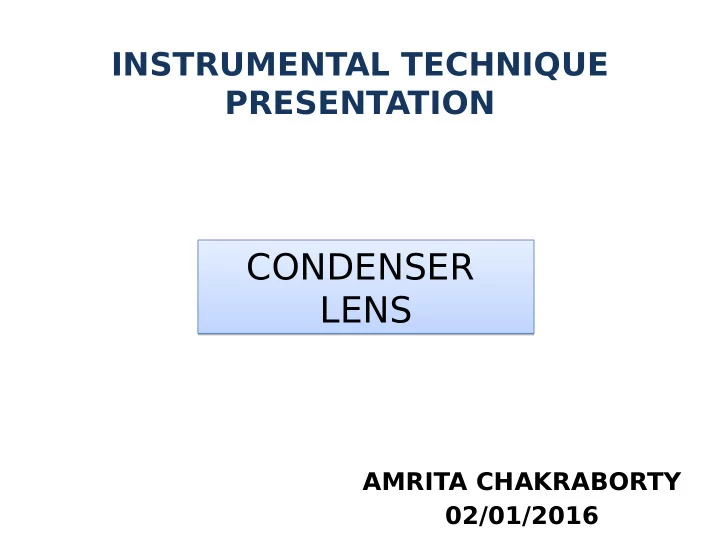

INSTRUMENTAL TECHNIQUE PRESENTATION CONDENSER CONDENSER LENS LENS AMRITA CHAKRABORTY 02/01/2016
• WHAT IS IT? • CONDENSER is a lens that serves to concentrate light from the illumination source in a microscope that is in turn focused through the object and magnifjed by the objective lens. • Used primarily in high effjciency illumination systems, condensers ofger superior aberration correction. • On upright microscopes, the condenser is located beneath the stage and serves to gather wavefronts from the microscope light source and concentrate them into a cone of light that illuminates the specimen with uniform intensity over the entire view fjeld. • Inverted (tissue culture style) microscopes mount the
• HISTORY • In the 17th century, the fjrst simple condensers were introduced on pre-achromatic microscopes ( Robert Hooke used a combination of a salt water fjlled globe and a plano-convex lens, and explained its effjciency). • English makers in the 18th century such as Benjamin Martin, Adams and Jones understood the advantage of condensing the area of the light source to that of the area of the object on the stage. This was a simple plano-convex or bi-convex lens, or sometimes a combination of lenses. • By 1837, the use of the achromatic condenser was introduced in France, by Felix Dujardin, and Chevalier . • By the late 1840s, English makers such as Ross, Powell and Smith; all could supply highly corrected condensers (purely empirical) with proper centering and focus. • Into the late 1870s, in Germany, mainly due to a misunderstanding of the basic optical principles involved, the leading German company, Carl Zeiss in Jena, ofgered nothing more than a very poor chromatic condenser. • In 1878, Ernst Abbe produced a very good achromatic design, in order to make satisfactory photographs of bacteria.
• Optical principles for lenses : A lens produces its focusing efgect because light travels more slowly in the lens than in the surrounding air, so that refraction, an abrupt bending, of a light beam occurs both where the beam enters the lens and where it emerges from the lens into the air.-- Because of the curvature of the lens surfaces, difgerent rays of an incident light beam are refracted through difgerent angles, so that an entire beam of parallel rays can be caused to converge on, or to appear to diverge from, a single point. This point is called the focal point, or principal focus(F), of the lens.
• How does it work? • Condensers typically consist of a variable-aperture diaphragm and one or more lenses. • Light from the illumination source of the microscope passes through the diaphragm and is focused by the lens(es) onto the specimen. • After passing through the specimen the light diverges into an inverted cone to fjll the front lens of the objective. • Condensers with numerical apertures above 0.95 perform best when a drop of oil is applied to their upper lens in contact with the undersurface of the specimen slide. This ensures that oblique light rays emanating from the condenser are not refmected from underneath the slide, but are directed into the specimen.
• Chromatic & Spherical Abberations : Chromatic aberration : caused by the variation in the refractive index of the lens in the range of light wavelengths Spherical Abberation : caused by the spherical curvature of a lens.
Types of Condenser Lenses : 1. Depending on imaging modality : 1. Bright fjeld : Objective collects only transmitted light. 1. Bright fjeld : Objective collects only transmitted light. 2. Dark fjeld : Objective collects only scattered light. 2. Dark fjeld : Objective collects only scattered light. 3. Phase contrast : Phase shifts in light passing through a 3. Phase contrast : Phase shifts in light passing through a transparent specimen is converted to brightness changes in the image. transparent specimen is converted to brightness changes in the image.
2.Depending on correction of optical abberation : 1. Abbe condense r : simplest, least expensive. Not corrected for 1. Abbe condense r : simplest, least expensive. Not corrected for either chromatic or spherical optical aberrations. either chromatic or spherical optical aberrations. 2. Aplanatic condenser : corrected exclusively for spherical (aplanatic) 2. Aplanatic condenser : corrected exclusively for spherical (aplanatic) optical aberrations. optical aberrations. 3. Achromatic condenser : corrected exclusively for chromatic 3. Achromatic condenser : corrected exclusively for chromatic (achromatic) optical aberrations. (achromatic) optical aberrations. 4. Aplanatic-achromatic condenser : well corrected for both 4. Aplanatic-achromatic condenser : well corrected for both chromatic and spherical aberrations and is the condenser of choice for chromatic and spherical aberrations and is the condenser of choice for use in critical color imaging with white light. use in critical color imaging with white light.
• Condenser Lens in Our Lab Inverted Fluorescence microscope Cytoviva
Recommend
More recommend